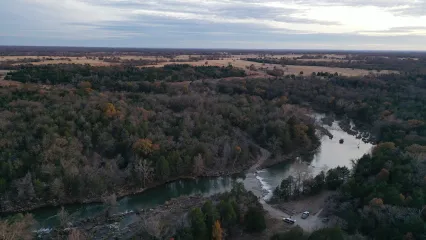
Before Oklahoma became a state, adventurous settlers were already seeking out land for home sites to raise families, livestock and crops in a landscape blanketed with prairie. These early pioneers coming westward into Oklahoma from heavily forested areas were surely amazed by the vast openness they saw dotted with an occasional tree. The veins of rivers and streams lined with trees were few and far between, yet they supplied the land and wildlife with a vital element of habitat-water.
Imagine walking or traveling by wagon for days through grass as tall as a horse's back and then coming upon a forested stream running with cool, blue water. Before you even think about what you'd say, the words flow from your mouth, "This is our new home." Little did these early pioneers know, they were stumbling upon lands that would later become some of the state's prime public hunting and fishing areas.
In 1896 Congress directed the Dawes Commission to begin making out the rolls of the Indian citizens in preparation for the land allotment process. Austin Britt Hughes and his wife of just one year, Mamie Cravatt received a total of eight allotments. Hughes selected them along the Blue River in current day Johnston County.
Changes to the land began in rapid progression as settlements were developed and families began to grow. Settlements became towns, and wagons were literally left in the dust with the invention of the automobile.
Travel route-like game trails, but wider and more deeply rutted, were established by constant use as civilization continued to crawl across the land. Natural river crossings were named based upon their locations, like the "Hughes Crossing" on the Blue River.
Hughes was an enterprising man and realized the uniqueness of the Blue River. On the east bank, he established possibly one of the first fishing and hunting camps in Oklahoma. For 50 cents a day (or $1 per car carrying no more than four passengers for four days), hunters as well as anglers and campers could enjoy the scenic beauty along the Blue River.
In 1950, the Hughes family sold the original allotments to local landowners, and in 1967 the Oklahoma Department of Wildlife Conservation purchased the property and established the Blue River Public Fishing and Hunting Area.
The Blue River PFHA is located in south-central Oklahoma about 11 miles northeast of Tishomingo in Johnston County. The area encompasses over 3,000 acres of prime wildlife habitat. The river meanders through the area over six miles, providing the opportunity to fish for native sunfish, catfish and bass.
The area is primarily managed for quality stream fishing and is highlighted by a winter trout fishery open from November through March. Along with the great opportunity to fish for trout is the natural scenic beauty of the stream and the surrounding landscape. The clear, spring-fed river cascades over waterfall after waterfall of granite boulders of the Arbuckle Mountains. Between each waterfall is a soothing pool of water often hiding a hungry fish. The continuous whispering sound of the water accompanied by the nearby songbirds is like a finely orchestrated symphony to your ears; total relaxation, until reality calls you back when a kid hollers with excitement, "I caught one!"
If you desire more solitude the area has several walk-in locations. You can walk up to two miles along the river, so be sure to take some drinking water and some snacks. While walking in toward the river, you can't help but notice granite boulders as big as trucks bulging up and out of the ground. Once you get to the river, you'll start to notice smooth-barked trees called seaside alders which are more common on the east coast, but not in Oklahoma. The banks of the river are heavily bordered by trees. However, there are numerous fishing access areas. Many anglers who frequent the river use hip boots or chest waders in the slow moving riffles of the river.
Successful trout anglers use a wide variety of spinning and fly fishing rods and lures. Ultra light spinning rods spooled with four to six-pound test line will get you hooked up with a feisty fish and provide you with plenty of excitement. Artificial bait anglers who fish for trout use 1/24 to 1/16 oz. spinners such as Panther Martins, Roostertails, Mepps and small spoons. Most bait anglers rig their trout hooks with whole kernel corn, salmon eggs, Velveeta cheese and Berkley Power Bait. It is suggested that anglers add a small split shot on their lines to help feel the gentle tug of a trout when it bites. For complete fishing regulations, be sure to read the current Oklahoma Hunting and Fishing Guide.
Deer, turkey and small game are plentiful for hunters looking for a new and challenging place to hunt. There are plenty of natural openings on the area that would provide prime opportunities for getting a shot off at your favorite game animal. All hunting is restricted to shotgun and archery only. Be sure to review the Oklahoma Hunting and Fishing Guide before entering the area.
Primitive campsites are available at no charge for campers who have a current Oklahoma hunting or fishing license. All other visitors must purchase a Wildlife Conservation Passport to enter or use the Blue River Area, unless exempt. For a complete listing of exemptions and more detailed information, check out the Oklahoma Hunting and Fishing Guide, or on your way into the area, stop at the Information Center located near the area headquarters.